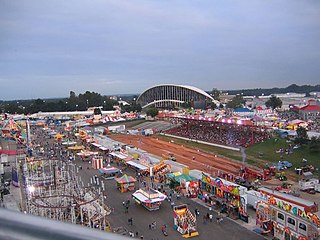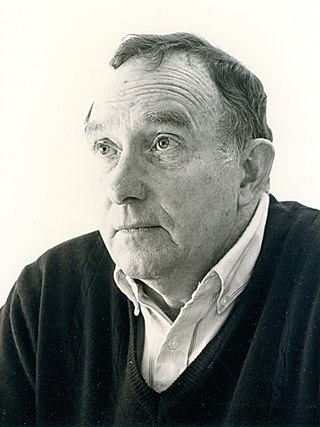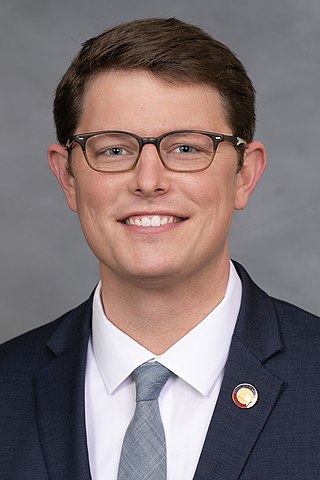
The North Carolina State Fair is an American state fair and agricultural exposition held annually in Raleigh, North Carolina. Founded in 1853, the fair is organized by the North Carolina Department of Agriculture and Consumer Services. It attracts around a million visitors over eleven days in mid-October.
Romaldo 'Aldo' Giurgola was an Italian-Australian academic, architect, professor, and author. Giurgola was born in Rome, Italy in 1920. After service in the Italian armed forces during World War II, he was educated at the Sapienza University of Rome. He studied architecture at the University of Rome, completing the equivalent of a B.Arch. with honors in 1949. That same year, he moved to the United States and received a master's degree in architecture from Columbia University. In 1954, Giurgola accepted a position as an assistant professor of architecture at the University of Pennsylvania. Shortly thereafter, Giurgola formed Mitchell/Giurgola Architects in Philadelphia with Ehrman B. Mitchell in 1958. In 1966, Giurgola became chair of the Columbia University School of Architecture and Planning in New York City, where he opened a second office of the firm. In 1980 under Giurgola's direction, the firm won an international competition to design a new Australian parliament building. Giurgola moved to Canberra, Australia to oversee the project. In 1989, after its completion and official opening in 1988, the Parliament House was recognised with the top award for public architecture in Australia.

The Ritcher House is considered to be one of the best examples of Frank Lloyd Wright's Usonian mode of design in North Carolina. Located near downtown Raleigh, the house is one of many Modernist houses that were built in the city during the mid-20th century. Most of these homes were designed by faculty members of the North Carolina State University School of Design. Established in 1948 by Henry Kamphoefner, the school hired several Modernist architects as faculty members. Kamphoefner was awarded the North Carolina Award for Fine Arts in 1978 for his work and for his encouragement of other Modernists to build and design homes in the state. On September 21, 1994, the Ritcher House was listed on the National Register of Historic Places. The house is also a Raleigh Historic Landmark.

The Henry L. Kamphoefner House was the first Modernist house built in Raleigh, North Carolina. During the mid-20th century, faculty members from the School of Design located at North Carolina State College designed and built several modernist houses in Raleigh for themselves, other faculty, and a few clients. Henry L. Kamphoefner, originally the head of the University of Oklahoma's architecture program, became the first dean of the college's School of Design. Kamphoefner was awarded the North Carolina Award for Fine Arts in 1978 for his work and encouragement of other Modernists to build and design homes in the state. In 1977 he was awarded the Topaz Medallion for Lifelong Achievement in Architecture by the Association of Collegiate Schools of Architecture. The Kamphoefner House was listed on the National Register of Historic Places in 1996 and is designated a Raleigh Historic Landmark.
George Matsumoto was a Japanese-American architect and educator who is known for his modernist designs.

Henry Leveke Kamphoefner was a champion of Modernist architecture and is most well known for bringing modern architecture to the southern United States and North Carolina in particular, as the first Dean of the School of Design at North Carolina State University.

Frank Pierce Milburn was a prolific American architect of the late 19th and early 20th centuries. His practice was primarily focused on public buildings, particularly courthouses and legislative buildings, although he also designed railroad stations, commercial buildings, schools and residences. Milburn was a native of Bowling Green, Kentucky who practiced as an architect in Louisville from 1884 to 1889; Kenova, West Virginia 1890–1895; Charlotte, North Carolina; Columbia, South Carolina; and Washington, D.C. after 1904. From 1902 Milburn was architect for the Southern Railway.
Philip Goodwin Freelon was an American architect. He was best known for leading the design team of the Smithsonian Institution's National Museum of African American History and Culture.
Frank Harmon is a writer, architect, professor and public speaker in Raleigh, North Carolina.

The A. Conger Goodyear House is an NRHP listed historic home located at Old Westbury in Nassau County, New York.

The Smith House is a work of contemporary architecture designed by Richard Meier, a well-known architect born in 1934 who led the avant-garde modern architecture movement of the 1960s. The Smith House was planned starting in 1965 and completed in 1967 in Darien, Connecticut, and overlooks the Long Island Sound from the Connecticut coast. The 2,800 square-foot home has been featured in numerous books and has won various prestigious awards.
Raymond Frank Walser, commonly known as Frank Walser, was an American builder who operated in the Raleigh, North Carolina area from 1949 into the 1980s.
Leslie N. Boney Sr. (1880–1964) was an American architect who focused on schools. He designed approximately 1,000 schools or additions to schools, and his works appear in 51 of North Carolina's 100 counties.
Edward "Terry" Walter Rail Waugh was a South African architect known for helping to bring Modern architecture to the southern United States and North Carolina in particular through his association with the School of Design at North Carolina State College.
Arthur Ralph Cogswell Jr. was an American architect known for his work in the Modernist school, primarily designing homes in North Carolina.
Charles (Charlie) Hussey Boney was an American architect.
Jon Andre Condoret was a French American architect who infused North Carolina modernist architecture with European sensibility. Along with the works by Harwell Hamilton Harris, Henry L. Kamphoefner, Eduardo Catalano, George Matsumoto and others, Condoret's designs define the architectural demeanor of a U.S. state that has the fourth largest concentration of modernist houses after California, New York and Florida. According to his daughter, architect Arielle Schechter, Condoret's architecture brings “the natural world into homes,” embraces “the principles of passive solar design,” and uses “textures and materials in delightfully surprising ways.”

Ligon B. Flynn, FAIA, was an American architect who practiced in North Carolina — noted for his coastal residential projects in southeastern North Carolina, primarily in the Wilmington area.
Edward Lowenstein was an American architect known for his modernist home designs in Greensboro, North Carolina and as an educator and employer of architects Black, white, male, and female. Lowenstein was born in Chicago and went to Deerfield-Shields High School. He graduated from MIT in 1935.

Brian Austin Farkas is an American politician and State Representative who served District 9 in the North Carolina House of Representatives.








